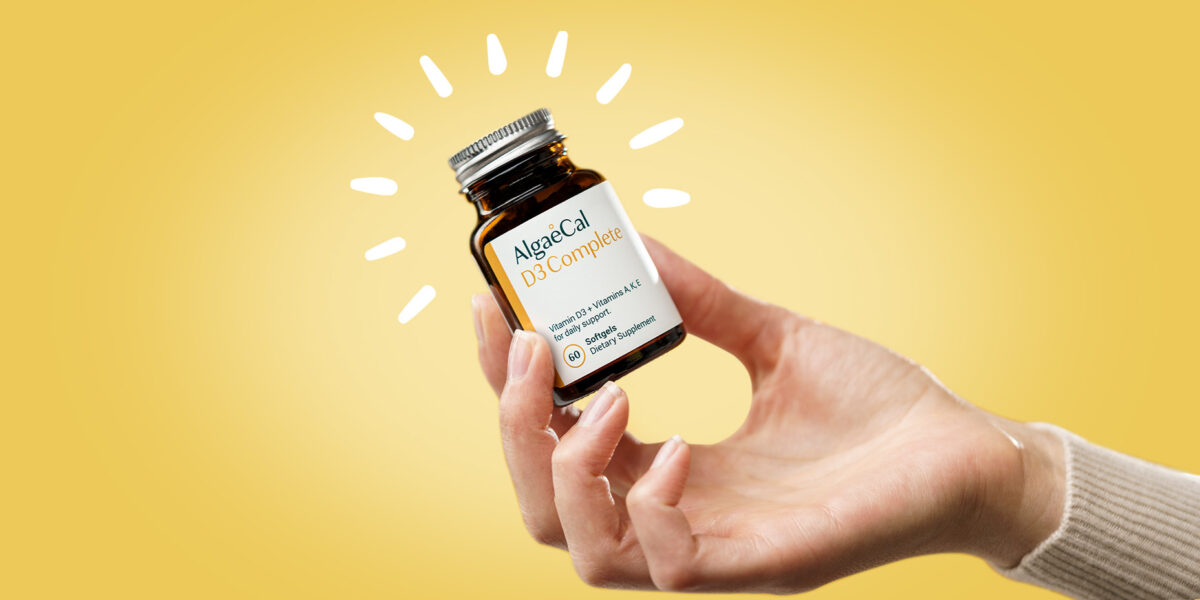Your body has over 30 trillion cells, and each one of them has a vitamin D receptor. That tells us that vitamin D is the only vitamin that every cell in your body requires! The vitamin D receptor is a switch that triggers the cell to express vital functions such as immune strength, bone health, mood balance, and more!
Without a steady supply of vitamin D, these functions will slow down, waver, and eventually cease to operate effectively. That’s why not just your bone health, but virtually every aspect of your health hinges on getting enough vitamin D [1].
But are we getting enough?
According to the National Institutes of Health (NIH), “vitamin D deficiency is more prevalent than ever, and high-risk populations should be screened.” The specific numbers vary depending on the risk group, but included in the NIH’s list of high-risk groups are nursing home residents, elderly patients, African American and Hispanic individuals—and women with osteoporosis.
In fact, the Linus Pauling Institute at Oregon State University reports that dietary intake surveys indicate 81% of children and adolescents (age 2-18 years) and 95% of adults are not meeting the Estimated Average Requirement (EAR).
That’s a problem because vitamin D has a hand in some of your most vital physiological processes, including bone health, immunity, cardiovascular health, and more. Simply put, if your vitamin D levels are low, your health will suffer.
And for many of us, our vitamin D levels are low.
So, how do we get vitamin D? That’s the easy question because we get vitamin D from just three sources: food, the sun, and supplements. The real question we need to answer is, “Are we getting enough, and if not, why?”
So let’s dig in and uncover why so many people struggle with low vitamin D levels, the best way to test your vitamin D, and what you can do to get your levels back up to an optimal range.
Risk Factors for Vitamin D Deficiency

Why are we all so vitamin D deficient? It’s because we get vitamin D from three sources: food, sunlight, and supplementation. Whether or not we are getting a sufficient amount depends on how much we are getting from each one, or from a combination of any or all of the three [2].
Here are some of the most common risk factors for vitamin D deficiency:
Lack of Sunlight
Vitamin D is often called the “sunshine vitamin” because when our skin is exposed to the sun, our bodies can manufacture its own vitamin D. Yale Medicine dermatologist David J. Leffell, says, “We each have vitamin D receptor cells that, through a chain of reactions starting with conversion of cholesterol in the skin, produce vitamin D3 when they’re exposed to ultraviolet B (UVB) from the sun.”
But, according to Harvard’s T.H. Chan School of Public Health, the following are some of the reasons exposure to UVB light is decreased, subsequently decreasing vitamin D absorption:
- “Correctly applied”, the use of sunscreen can reduce vitamin D absorption by more than 90%.
- Wearing full clothing that covers the skin.
- Spending limited time outdoors.
- Darker skin tones due to having higher amounts of the pigment melanin, which acts as a type of natural sunscreen.
- Older ages when there is a decrease in 7-dehydrocholesterol levels and changes in skin, and a population that is likely to spend more time indoors.
- Certain seasons and living in northern latitudes above the equator where UVB light is weaker. For example, in the northern hemisphere, people who live in parts of the U.S., Canada, and Norway can’t make enough vitamin D from the sun for up to six months of the year. Similarly, in the southern hemisphere, people living in Buenos Aires, and Cape Town, South Africa make far less vitamin D from the sun during their winter months (June through August) than they can during their spring and summer months. Though the body can store vitamin D from summer sun exposure, it needs to last for many months, but by late winter, many people in these higher-latitude locations can find themselves vitamin D deficient [3].
Obesity
Obesity is an epidemic all its own in the US, and unfortunately, along with all the other side effects that come with excess weight, it appears that vitamin D levels also take a hit.
Since vitamin D is a fat-soluble vitamin, once it enters your body (if it isn’t used immediately), it gets stored in your fat cells. This means that for people that have excess body fat, the vitamin D they produce or take in gets sequestered away in their fat tissue and doesn’t make it to circulation. In essence, the increased number of fat cells dilutes the available vitamin D [4].
Older Age
As you age, your ability to synthesize vitamin D through your skin (via sunlight) diminishes. This is a natural side effect of the aging process, and it’s one of the primary reasons we see so much vitamin D deficiency in older populations [5].
Medications
Certain medications can block or interfere with vitamin D synthesis, while others increase its degradation. Some examples include laxatives, steroids, cholesterol-lowering drugs, and weight-loss drugs [6].
Low Dietary Intake or Malabsorption of Vitamin D
Although sunlight is the primary source of vitamin D for most people, you can still get a fair percentage of your vitamin D (10-50%) through foods like salmon, cod, sardines, eggs, and mushrooms.
Unfortunately, many people today suffer from malabsorption syndromes like IBS, IBD, Crohn’s disease, and Celiac disease, all of which will make it more difficult to absorb nutrients like vitamin D [7][8].
Certain Health Conditions
Health conditions like kidney disease and liver disease can impair vitamin D synthesis and activation due to these conditions’ impact on enzymes involved in vitamin D activity [9][10].
Signs and Symptoms of Vitamin D Deficiency
Vitamin D deficiency symptoms often come on slowly, so it’s helpful to know what to look for. Some of the most common signs that your vitamin D levels are low include:
Signs of Vitamin D Deficiency
- Muscle weakness or cramps
- Bone or joint pain
- Chronic pain
- Fatigue
- Hair loss
- Depression and/or anxiety
- Restless sleep
- Poor concentration
- Weakened immunity
- Headaches
Long-Term Concerns Of Vitamin D Deficiency
If your vitamin D levels remain chronically low, it can lead to more serious issues, including:
- Osteoporosis
- Osteomalacia
- Rickets (in children)
- Secondary hyperparathyroidism
Other conditions linked to low vitamin D levels include:
- Diabetes [11]
- Dementia [12]
- Heart disease [13]
- Fertility [14]
- PCOS [15]
- Autoimmunity [16]
- Metabolic syndrome [17]

How To Test For Vitamin D Deficiency
A simple blood test will tell you how much vitamin D is in your circulation and indicate whether or not you need to increase your vitamin D levels. It used to be that you had to have your blood drawn at a lab, but now you can test your vitamin D levels with a simple at home test. All it takes is a quick prick of your finger, then mail the sample off and you’ll have your results back in around five business days.
How To Increase Your Vitamin D Levels
If you find that your vitamin D levels are low or just want to get ahead of potential deficiency, there are a handful of ways to increase your levels.
First, try to incorporate more vitamin D rich foods into your diet. There are not a lot of foods high in vitamin D, but vitamin D does naturally occur in certain foods like salmon, cod, sardines, tuna, mackerel, beef liver, and eggs. When choosing food, it’s important to look for food that’s been properly raised. Studies suggest that wild-caught salmon is higher in vitamin D (and other nutrients) than farmed salmon. Similarly, eggs from free-range pastured chickens that were exposed to sunlight exhibited three to four times higher levels of vitamin D than chickens raised indoors.

The only vegetarian source of vitamin D is found in mushrooms exposed to UV light.
The lack of vitamin D in many foods is why foods like milk, cereal, and some orange juices are vitamin D2- and D3-fortified. In fact, vitamin D enriched foods helped reduce rickets in children, but we haven’t seen the same result when it comes to osteoporosis in adults.
Next, try to get more natural sunlight throughout the day. Synthesis of vitamin D through your skin via sunlight is one of the most effective ways to naturally increase your levels, with some research showing that just twenty minutes per day of sun exposure can prevent vitamin D deficiency [18]. That’s why vitamin D is called the “sunshine vitamin.”
That said, this comes with two disclaimers. First, studies show that due to the UV rays and location of the sun during certain times of the year (November to February), sun exposure may result in little to no vitamin D synthesis. This is especially relevant in certain areas in the Northern US [19][20].
Second, because UVB light can burn the skin and cause skin cancer, you want to be sure to avoid burning or over exposure to the sun. The sun is most intense at midday which means it will take less time to get sufficient sunlight, but if you’re concerned about overexposure, simply choose to spend time in the sun in the mornings or afternoon.
Sunlight offers other health benefits as well. It supports better sleep and helps set your circadian rhythms by regulating the levels of serotonin and melatonin. It’s also been found to protect against type 1 diabetes, multiple sclerosis, and several forms of cancer..
Ideally, you can sustain healthy vitamin D levels through diet and exposure to sunlight. But not everyone can or does. This is why so many people are turning to vitamin D supplements.
Adding a high-quality vitamin D supplement to your regimen is an excellent way to ensure you keep your vitamin D at an optimal level. Fortunately, your body doesn’t process vitamin D differently, regardless of whether it comes from food, the sun, or supplementation. When searching for a vitamin D supplement, make sure that it’s in the D3 form,as opposed to D2, because vitamin D3 is more active and, therefore, more efficient at raising your vitamin D levels.
You’ll also want to ensure that your supplement contains an adequate dose of vitamin D.

Optimal Level and Recommended Intake of Vitamin D
There is some debate about the optimal level of vitamin D in the blood.
Though there is wide agreement that 20 ng/mL or below constitutes vitamin D deficiency, the range of what constitutes an optimal level of vitamin D can vary. That said, the National Institute of health places an optimal level between 30-50 ng/mL. That aligns with other experts who find the optimal level to be “concentrations around 48 ng/mL.” The evidence suggests that levels in the low 40s is a reasonable and healthy target to shoot for.
Recommended Intake of Vitamin D
The simple answer is, it depends on a variety of factors such as age, weight, skin color, and even geographical location affect the amount of Vitamin D a person needs. At the lower level, recommendations from The National Institutes Of Health and the Endocrine Society range from 400-2000 IU. Whereas a recent large-scale study from Germany recommends a much higher range. That’s why it’s always best to discuss your Vitamin D needs with your healthcare provider, who has the full overview of your personal needs and medical history.
AlgaeCal’s Vitamin D3 Complete contains 1000 IUs, plus vitamins A, E, and K because, when combined, these four vitamins complement one another to support an impressive range of health benefits.
Ultimately, your optimal levels will depend on your current vitamin D levels, health status, and health goals.
Takeaway
Vitamin D is crucial to so many aspects of your health, that it’s probably a good idea to make sure you’re not deficient. If you have yet to check your vitamin D levels, a simple home test will let you know where you stand.
In the meantime, taking a high-quality vitamin D3 supplement can help you stay ahead of potential deficiencies and give you peace of mind that your body is receiving the nutrients it needs – even when you’re stuck inside all day.
For more on the latest research related to health, nutrition, and aging gracefully, sign up for the AlgaeCal Newsletter.
FAQs
How much vitamin D3 should I take daily?
It depends on a variety of factors such as age, weight, skin color, and even geographical location affect the amount of Vitamin D a person needs. At the lower level, recommendations from The National Institutes Of Health and the Endocrine Society range from 400-2000 IU. Whereas a recent large-scale study from Germany recommends a much higher range. That’s why it’s always best to discuss your Vitamin D needs with your healthcare provider, who has the full overview of your personal needs and medical history.
What are the main benefits of vitamin D3?
Vitamin D3 is the most active form of vitamin D, making it the most efficacious in raising your vitamin D levels. This nutrient plays a crucial role in bone health and immunity and has a hand in many other physiological processes.
What are the symptoms of vitamin D3 deficiency?
Some of the most common symptoms of vitamin D deficiency include muscle aches or weakness, fatigue, mood changes, sleep disturbance, hair loss, weakened immunity, and poor concentration.
What are the symptoms of vitamin D3 deficiency?
Some of the most common symptoms of vitamin D deficiency include muscle aches or weakness, fatigue, mood changes, sleep disturbance, hair loss, weakened immunity, and poor concentration.
What happens when your vitamin D is really low?
Chronically low vitamin D can impair calcium absorption and lead to issues with bone health, including osteomalacia and osteoporosis. Furthermore, low vitamin D levels may increase your risk for several other health conditions, including diabetes, heart disease, dementia, autoimmune disease, and more.
What is the difference between vitamin D and vitamin D3?
Vitamin D3 is a form of vitamin D. The primary difference between the two is that vitamin D3 is more active and, therefore, more effective than other forms of vitamin D.





Teresa Robinson
February 22, 2024 , 12:18 amVitamin D is also necessary for those who have had cancer.